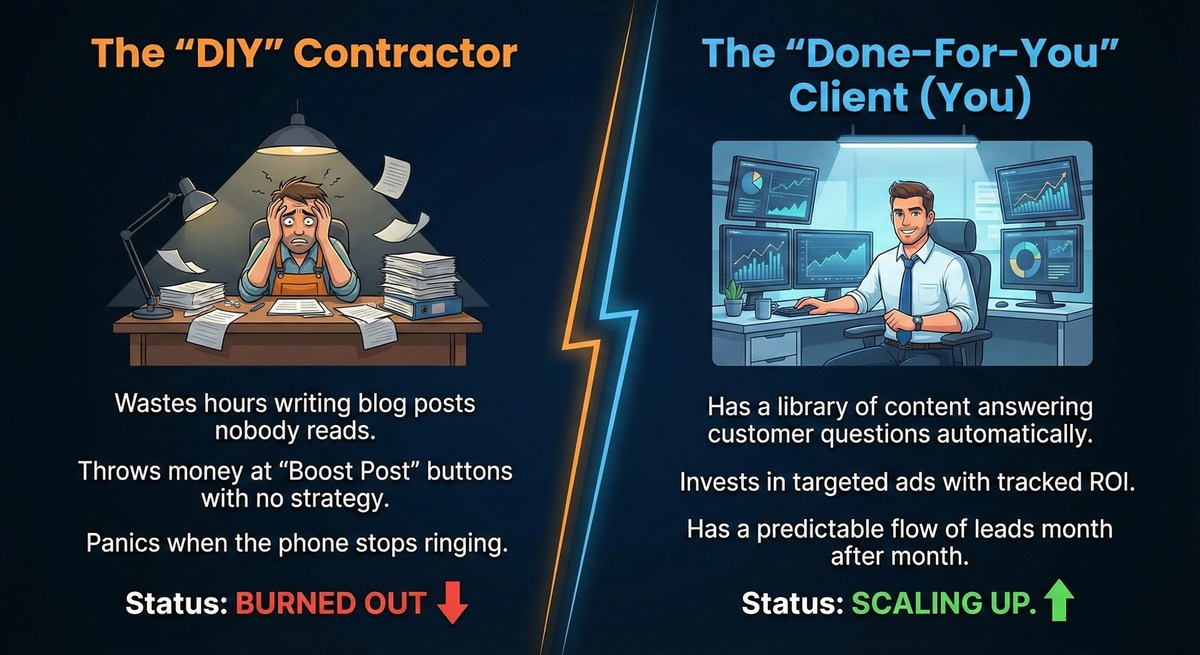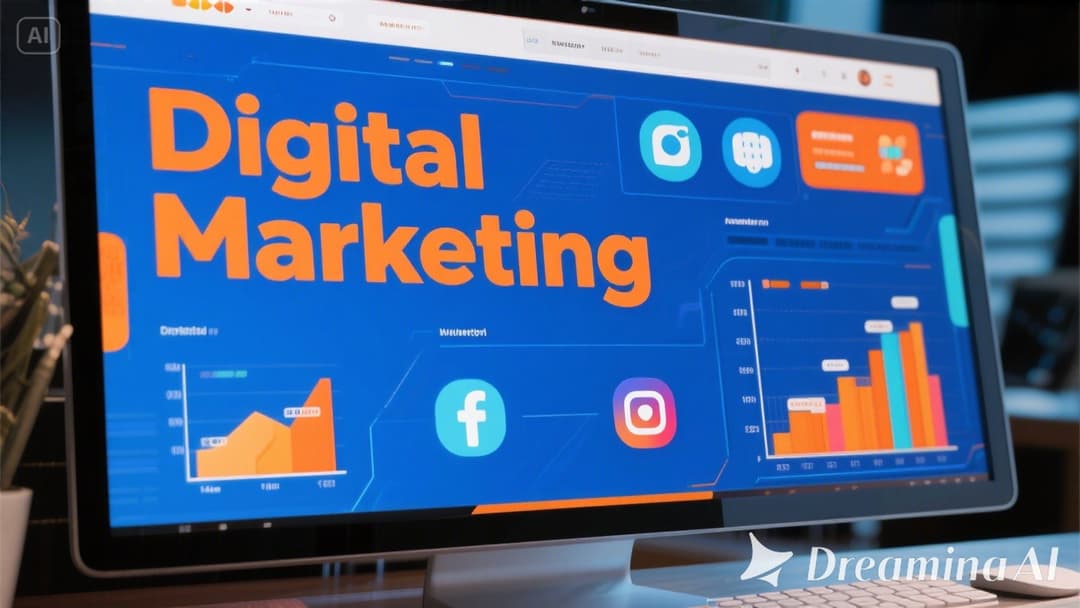Support center (714) 707-2483
Digital Marketing for local Contractors
What digital marketing services help local contractors get more leads?
Local contractors get the best results from a combo of local SEO, Google Business optimization, paid ads, and reputation management.
- Local SEO helps your business show up when people search “contractor near me.”
- Google Business optimization boosts map rankings and call volume.
- Paid ads (Google & Facebook) drive fast, targeted leads.
- Reputation management keeps your reviews strong — a massive trust factor for homeowners.
- The sweet spot is using all of them together so you rank, get clicks, and convert.
Why is digital marketing important for contractors who rely on local customers?
Homeowners don’t flip through phone books anymore — they Google everything.
If you’re not visible online, you’re invisible period.
Digital marketing keeps contractors in front of ready-to-buy customers the moment they need you, whether it's roofing, plumbing, remodeling, or electrical work. Strong online presence = more estimates, more booked jobs, and long-term brand credibility.
How fast can local contractors see results from digital marketing?
Most contractors see noticeable wins in 30–90 days, depending on the strategy:
- Paid ads: fast leads, often same day
- Local SEO: growth within 6–12 weeks, compounding over time
- Content & reviews: steady month-over-month lift
- Google Business: major improvement in 30–60 days after proper optimization
- The key is consistency. Digital marketing isn’t magic — it’s momentum. But once it’s rolling, lead flow becomes predictable instead of seasonal guesswork.

The Hard Truth: The Best Technician Doesn't Always Win. The Best Marketer Does.
Let’s be real. The home services industry is worth over $800 billion, but 90% of that revenue goes to the top 10% of companies.
While you are out fixing a water heater at midnight or rewiring a panel in the July heat, your competitors are stealing your future customers online.
- They are ranking #1 on Google when a furnace dies.
- They are the first call when a basement floods.
- They are charging premium rates because they look like the premium option.
The Reality Check:
- 98% of consumers search online for local repairs.
- 74% of them call the first business they see with good reviews.
- 3 Seconds: That’s how long you have to convince them to call you before they click "Back."
You don't need a "pretty website" or a viral TikTok dance. You need a Customer Acquisition System that works as hard as you do.
Why Most Home Services Marketing Fails
Stop "Dabbling" in Marketing. Let Us Build Your Machine.
We don't sell "posts" or "likes." We sell booked appointments. Here is the exact ecosystem we build for your business to dominate the local market in 2025.
1. Local SEO: The Foundation That Pays Forever
Most agencies guess at keywords. We use data. We target the "Money Keywords" that drive emergency calls.
- What We Do: We optimize your site for high-intent searches like "Emergency Plumber Tampa" and "24/7 AC Repair," not just generic terms.
- The Result: You own the digital real estate in your city. When they search, they find you.
2. Google Business Profile: Your 24/7 Sales Rep
Your Google Map listing is your most valuable asset. If you aren't in the "3-Pack," you are invisible.
- What We Do: We manage your profile daily—uploading geo-tagged photos, seeding Q&As, and responding to reviews with keyword-rich answers.
- The Result: Higher visibility on Maps and immediate trust from potential customers.
3. Review Management: Social Proof on Autopilot
81% of people rely on Google Reviews to make a decision. One bad review can cost you thousands if not managed right.
- What We Do: We implement automated systems to request reviews the moment a job is closed, and we handle the responses professionally (so you don't have to argue with customers online).
- The Result: A 5-Star reputation that allows you to charge what you’re worth.
4. High-Intent PPC Advertising
Google Ads can be a goldmine or a money pit. The average cost-per-lead for home services is $90.92, but we aim to beat that by filtering out "tire kickers."
- What We Do: We build campaigns that only target people ready to buy now. No paying for clicks from people looking for "DIY plumbing tips."
- The Result: The phone rings with qualified leads who need service immediately.
Why "DIY" Marketing is Costing You Money
You wouldn't let a homeowner wire their own breaker panel just because they watched a YouTube video. So why are you trying to run your own SEO?
We don't guess. We follow a proven 2025 roadmap designed specifically for Home Services.
Phase 1: The Foundation (Weeks 1-4)
- Comprehensive Local SEO Audit.
- Fixing your NAP (Name, Address, Phone) across 50+ directories.
- Website speed optimization (Mobile-first).
Phase 2: The Authority Build (Months 2-3)
- Launch of the Review Generation System.
- Creation of "City + Service" landing pages (e.g., "Drain Cleaning Brandon").
- Deployment of Google Ads for immediate cash flow.
Phase 3: Market Domination (Month 4+)
- Scaling successful ad campaigns.
- Advanced Video Marketing (Showcasing your best work).
- Email Reactivation campaigns to turn past customers into repeat maintenance contracts.

Investment & ROI: What to Expect
Real marketing requires a real budget. We work with contractors who are ready to invest in growth.
The "Growth" Tier (~$2,500/mo spend)
- Ideal for: Growing teams (2-5 trucks).
- Focus: 50% Google Ads, 30% SEO/Maps, 20% Content.
- Goal: Consistent 25-40 qualified leads per month.
The "Domination" Tier (~$7,500/mo spend)
- Ideal for: Established companies (6+ trucks) looking to crush competitors.
- Focus: Aggressive Ads, High-Production Video, Full-Scale SEO.
- Goal: Market leadership and 50+ qualified leads per month.
Note: We measure success in CPL (Cost Per Lead) and ROAS (Return on Ad Spend). If the math doesn't work, we don't do it.
The ROI Reality Check: Why Cheap Marketing is Expensive
We know those numbers might seem high if you’re used to paying a cousin $500 to "run your Facebook." But let’s look at the actual math of a home service business.
If your average ticket for a new HVAC install or a major plumbing repipe is $4,000+, you only need 1-2 extra jobs per month to cover our entire base fee. Everything else is pure profit.
When you hire us, you aren't spending money. You are buying a customer acquisition machine.
If we spend $1 to make you $5, how many dollars would you give us? (Hint: The answer should be "All of them.")
Your First 90 Days: The Ramp-Up Blueprint
We don’t believe in "magic buttons." Real results take building. Here is exactly what happens once you sign the agreement. We don't ghost you after the sale.
Month 1: The Foundation Build (The "Quiet" Month)
- We tear down and rebuild your tracking systems so we know where every penny goes.
- We audit and correct your directory listings (NAP).
- We build out high-converting landing pages.
- Expectation: Low lead volume, high back-end activity. We are building the engine.
Month 2: The Launch & Calibration
- Google Ads go live targeted at high-intent keywords.
- Review generation systems start running.
- We gather data on which keywords are driving calls, not just clicks.
- Expectation: Leads start flowing. Cost Per Lead will be higher initially as we dial in the campaigns.
Month 3: Optimization & Scaling
- We cut keywords that are wasting money.
- We double down on the ad groups driving the best jobs.
- SEO efforts begin to show initial traction on Google Maps.
- Expectation: Consistent lead flow. Cost Per Lead decreases. We begin discussing scaling budgets.
Our Accountability Promise: No Smoke and Mirrors
We are sick of agencies that send confusing PDF reports full of "impressions" and "reach" to hide the fact that they aren't making you money.
When you partner with us, you get:
- A Real-Time Dashboard: See exactly how many calls, forms, and bookings we generated today.
- Call Recording: Listen to the leads coming in to ensure they are quality.
- You Own Everything: You keep your Ad accounts, your website, and your data. If we ever part ways, you don't lose your assets.
- No Long-Term Handcuffs: We work on month-to-month agreements. We have to earn your business every 30 days.
Your Service Area is Up for Grabs. Who’s Going to Take It?
Every day you wait is another emergency water heater replacement, another AC install, and another rewiring job going to the competitor ranked #1 above you.
You have the trucks. You have the skills. You just need the calls.
We aren't looking for hundreds of clients. We are looking for a few serious partners ready to dominate their local map.
Let's have an honest conversation about your market. No high-pressure sales tactics. Just a look at the data, your competition, and what it will actually take to win.

Frequently Asked Questions
Most contractors see the best results from local SEO, Google Business Profile optimization, paid ads, and consistent reviews. These work together to boost visibility and generate steady leads.
Optimize your Google Business Profile, collect five-star reviews, run targeted Google Ads, and make sure your website is fast, mobile-friendly, and built for conversions.
Paid ads can bring leads within hours, while SEO and Google Business improvements usually show strong results in 30–90 days with consistent effort.
Local SEO helps your business show up when homeowners search “contractor near me,” “plumber in [city],” or similar terms. Higher rankings = more calls, more quotes, more jobs.
Yes. Google Ads generate fast, high-intent leads, while Facebook Ads are great for branding and retargeting. Together, they're a powerful combo for local businesses.
Ask customers for reviews, respond to all feedback, fix outdated information online, and use automated tools to manage reviews across multiple platforms.
Absolutely. Your website is your “digital storefront.” It builds trust, shows your work, explains your services, and helps convert visitors into booked jobs.
Before-and-after photos, short videos, project highlights, customer testimonials, FAQs, and local service pages all build trust and boost search rankings.


